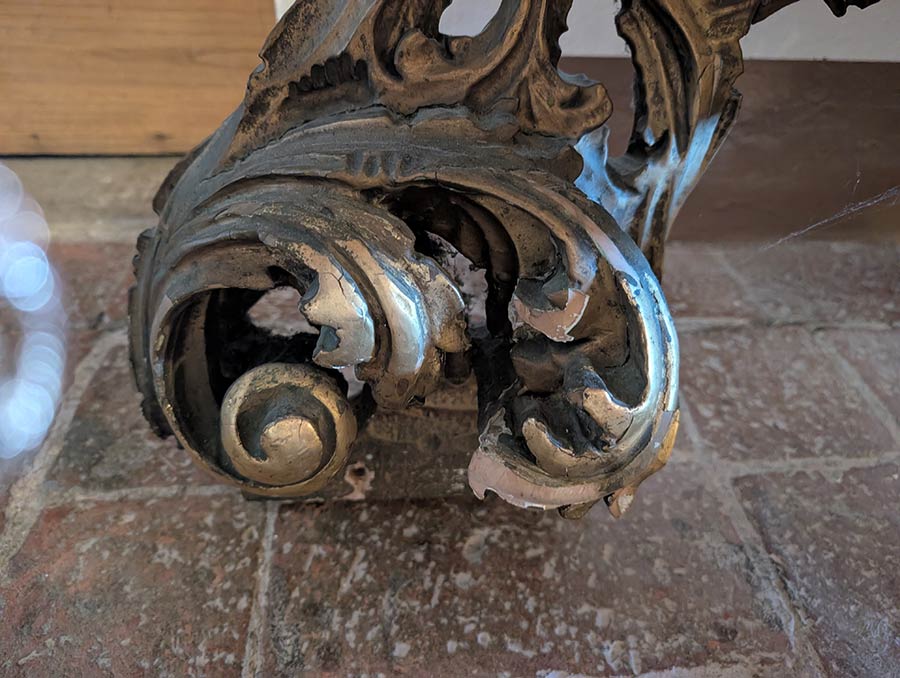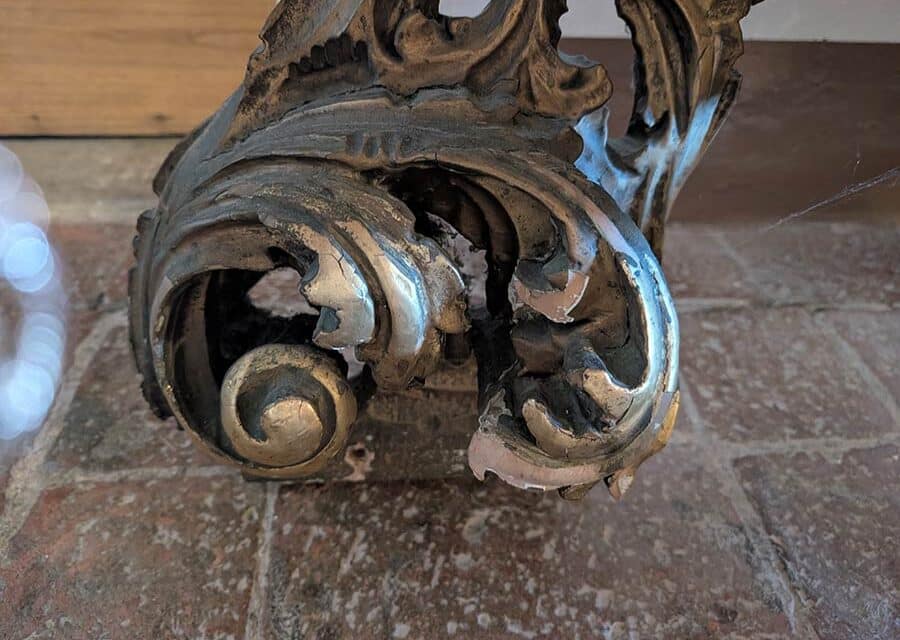The Tuscan sun was already warming the cobblestones when I arrived at the Arezzo Antique Fair — that glorious once-a-month treasure hunt that transforms the medieval streets into an open-air museum of objects for sale. My eyes, as always, darted between stalls, scanning for one thing and one thing only: a gold oversized wooden mirror frame.
And there it was.
Tall, imposing, with the faded opulence of a Medici ballroom. Its curves whispered Baroque. The gilding was chipped, but in a way that told a story, not a tragedy. The dealer leaned in, lowering his voice: “Seicento. Seventeenth century. Tuscan.”
I knew instantly this wasn’t a quick decision. Antique Italian gold wooden mirror frames are a minefield — part glamour, part gamble. And unless you know exactly what to look for, you could easily part with thousands for something made in a workshop last year.
Here’s how I confirmed mine was the real deal — and how you can spot one too.

1. Understand the Italian Timeline of Mirror Frames
If you’re buying in Italy, knowing the historical context helps you read the frame like a book.
- 17th Century (1600s – Baroque) – Expect grandeur. Carving is deep and theatrical, with scrolling acanthus leaves, cherubs, shells, and architectural flourishes. Gilding is heavy but mellowed by centuries. Symmetry is key.
- 18th Century (Rococo to Neoclassicism) – Carving becomes lighter, more playful. Rococo frames have asymmetry and floral flourishes, Neoclassical ones have straight lines and Greek motifs.
- 19th Century (Revival Styles) – Workshops often copied earlier designs. Carving is often machine-assisted, details sharper but lacking the irregular “hand” of a true Baroque craftsman.
Gracie’s Tip: If the dealer can’t tell you which century or style your piece belongs to — walk away. Knowledgeable sellers know their art history.

2. Look for True Hand-Carving
Seventeenth-century Tuscan mirror frames were carved from solid wood by hand, often in sections joined together. Here’s what to check:
- Irregularities – No two leaves or scrolls should be identical. Human hands vary pressure; machines do not.
- Tool Marks – Look closely under the gilding, especially where chips have occurred. You might see chisel marks or uneven gouges.
- Back Construction – Early frames often have dovetail joints or wooden pegs, not modern screws or staples.
At the Arezzo market, I ran my fingertips over the edges. The acanthus leaves felt slightly uneven, the curls imperfectly matched — exactly what I wanted to feel.

3. Test the Patina of the Gilding
Italian gold wooden mirror frames were typically water-gilded with gold leaf over gesso (a chalky underlayer). Over centuries, gold leaf wears in an uneven, organic way.
Signs of genuine age:
- Oxidation & Warmth – Old gold leaf develops a warm, honeyed glow, not the brassy yellow of modern gold paint.
- Red Bole Layer – If you see reddish clay under the gold where it’s worn, it’s a sign of traditional gilding.
- Micro-Cracking – Look for fine craquelure in the surface; it should be irregular, not a printed pattern.
At Arezzo, I took my pocket magnifier out — yes, I carry one — and saw that deep terracotta bole peeking through in spots. My heart skipped a beat.

4. Inspect the Wood from the Back
The front tells you glamour, the back tells you truth. Turn the mirror around (dealers don’t always love this, but insist).
- Wood Type – Tuscan frames often used softwoods like poplar or pine, aged to a dark, almost smoky brown.
- Wormholes – Old wormholes are irregular in size and not perfectly round. Modern fake “worming” is too neat.
- Oxidation – Wood oxidises to a rich tone; if it’s pale or raw, it’s been recently cut or replaced.
Mine had an uneven, blackened back, with the soft edges of centuries of handling — nothing freshly sawn.

5. Check for Authentic Old Repairs
A truly old frame will have scars. Look for:
- Small wood inserts replacing broken carving.
- Patches of newer gilding in hard-to-see places.
- Tiny nails or glue seams holding fragile ornament in place.
Seventeenth-century owners treated mirrors as investments. Repairs were made with care — often using period-correct materials. The one I bought had an old repair to the top crest — not a flaw, but a badge of honour.
6. Smell the Age
It sounds eccentric, but yes — smell the wood. Antique frames have a faint, musty scent from centuries in palazzi and villas. Fresh wood or strong chemical smells suggest new manufacture or recent restoration.
When I brought my nose close, I smelled dust, beeswax, and the faint ghost of an old fireplace. That was Tuscany in a scent.
7. Glass Isn’t Always Original
Seventeenth-century mirrors often had mercury glass, which has a slightly wavy surface and tiny black “sparkles” from oxidation. Many have been replaced over time — and that’s fine, as the value lies mostly in the frame.
If the glass is too perfect, it’s likely a later replacement. Don’t be put off — it just means the mirror was updated for use.
8. Provenance Adds Value
In Italy, provenance can be tricky, but dealers at reputable markets like Arezzo often know where a piece came from.
Ask:
- “Was this from a private villa or estate sale?”
- “Do you have any documentation?”
- “Who owned it before?”
My dealer told me it came from a villa outside Cortona — a story I can’t verify but fits the style and age.
9. Beware of Clever Fakes
Italy is full of 20th-century reproductions. Here’s how to spot them:
- Perfect Symmetry – Machines cut perfect patterns; hands don’t.
- Uniform Gilding – If it looks flawless everywhere, it’s probably not old.
- Wrong Weight – Old frames are surprisingly light for their size, as the wood dries over centuries. New frames often feel heavier because the wood retains moisture.
10. Price Is a Clue
If a dealer offers you a “17th-century Tuscan” for €200, smile and walk away. Genuine large Baroque gold frames can fetch several thousand euros, depending on size and condition.
I paid a fair price — not a bargain, but the kind of price that buys you both beauty and history.
Gracie’s Final Word
Buying an antique gold wooden mirror frame in Italy is part romance, part detective work. It’s about trusting your eye, your fingertips, and your instincts.
When I stood back from my Arezzo find, I imagined the rooms it had reflected — candlelit salons, silk-clad guests, whispered intrigues. That’s the joy of an authentic piece: it’s not just decoration, it’s a witness to centuries.
And now, it hangs in my home, catching the Tuscan light in its softened gold, a reminder that some beauty never fades — it only mellows with time.















You must be logged in to post a comment.